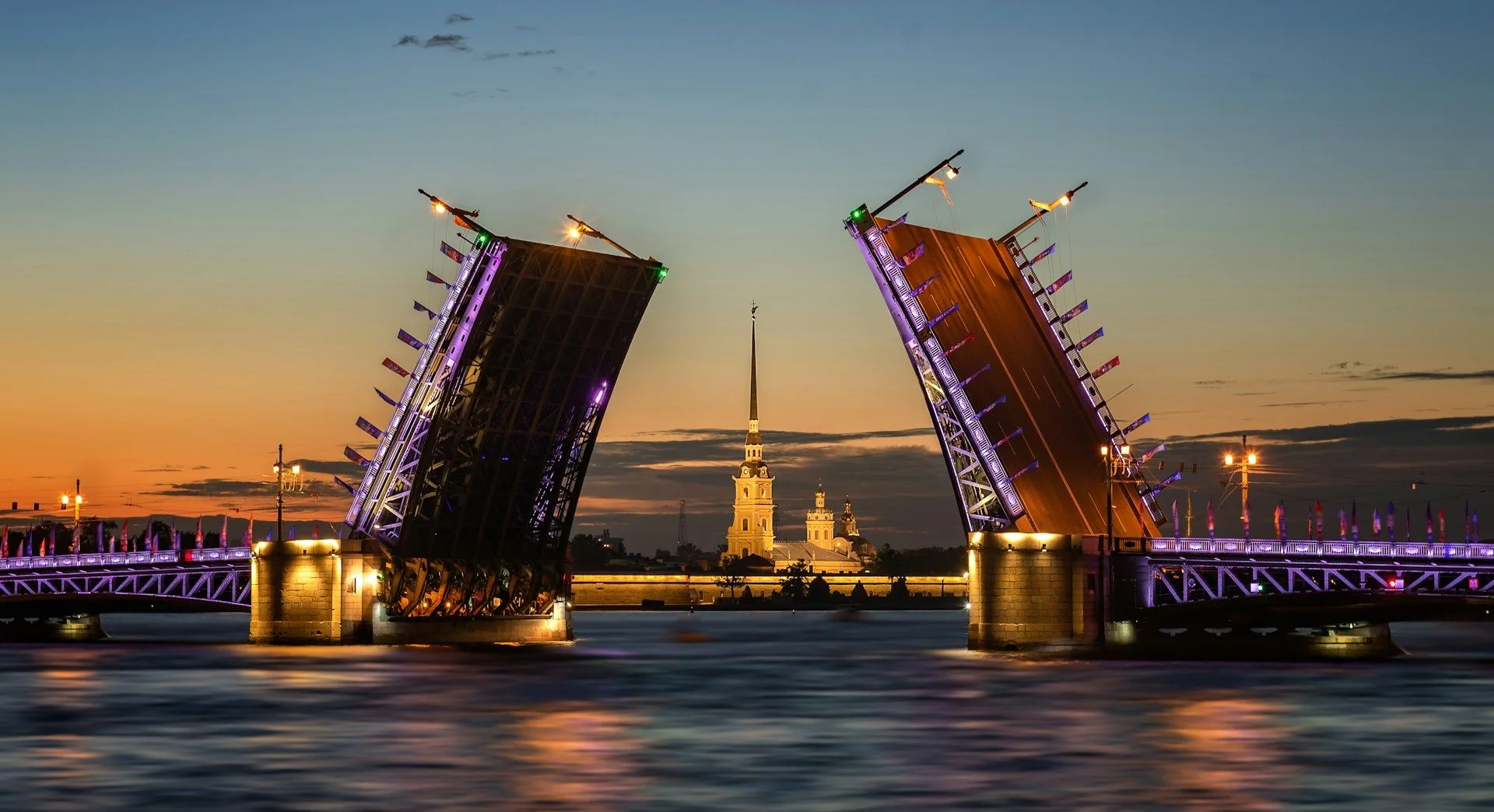Your Ultimate Saint Petersburg Travel GuideImperial elegance, canal-side beauty and rich cultural heritage.

Advantages of traveling
to Turkey
Russia’s cultural capital on the water
Saint Petersburg blends palaces, theaters, and canals into a walkable open-air museum of imperial grandeur.
White Nights and timeless inspiration
Each summer, the city glows until midnight — a poetic season of festivals, concerts, and moonlit strolls.
Art, architecture, and royal legacies
Home to the Hermitage, Fabergé, and Romanov history — Saint Petersburg is where Russia’s soul meets the world.
Russia’s cultural capital on the water
Saint Petersburg blends palaces, theaters, and canals into a walkable open-air museum of imperial grandeur.
White Nights and timeless inspiration
Each summer, the city glows until midnight — a poetic season of festivals, concerts, and moonlit strolls.
Art, architecture, and royal legacies
Home to the Hermitage, Fabergé, and Romanov history — Saint Petersburg is where Russia’s soul meets the world.

Useful articles
and recommendations from experts
Tourism in Saint Petersburg: Russia’s Imperial Jewel of Culture, Canals, and Creativity
Why Saint Petersburg Is One of Europe’s Most Beautiful Cities
Saint Petersburg, often called the “Venice of the North,” is a city of bridges, pastel-colored palaces, world-famous museums, and classical music drifting through the air. Founded by Peter the Great in 1703 as Russia’s window to the West, it quickly became a showcase of European influence and Russian ambition. Today, tourism in Saint Petersburg offers a rich blend of history, architecture, art, and atmosphere — all set against a stunning Baltic backdrop.
The city is walkable, romantic, intellectual, and surprisingly international. Whether you’re exploring baroque palaces, floating down the Neva River, or watching ballet in a 19th-century theater, Saint Petersburg surrounds you with beauty and significance at every turn.
Must-See Sights and Cultural Icons
At the heart of Saint Petersburg is The Hermitage Museum — one of the largest and oldest art museums in the world. Located in the opulent Winter Palace, it houses works by da Vinci, Rembrandt, Michelangelo, and Van Gogh, alongside imperial Russian art and décor.
Nearby, Palace Square and the Admiralty form a grand ensemble of neoclassical architecture, while Saint Isaac’s Cathedral offers a panoramic view from its gilded dome. The Church of the Savior on Spilled Blood, with its colorful onion domes and mosaics, marks one of the city’s most photographed landmarks.
The Peter and Paul Fortress — the city’s original citadel — holds the tombs of the Romanovs and a fascinating museum about the city’s founding. Smolny Cathedral, the Mariinsky Theatre, and Fabergé Museum complete the core must-sees for lovers of history and the arts.
Rivers, Canals, and Bridges
Saint Petersburg is built across more than 40 islands and crossed by 342 bridges. Its system of rivers and canals rivals that of Amsterdam or Venice. Taking a canal boat tour is among the best ways to appreciate the city’s symmetry, skyline, and palaces.
The Neva River is the lifeline of the city, and each night in summer, the raising of its drawbridges becomes a dramatic performance that draws crowds along the embankments. Trinity Bridge, Palace Bridge, and Bolsheokhtinsky Bridge are among the most iconic crossings.
Along the riverside, you’ll find picturesque embankments, swan-filled canals, and views of glowing domes reflected in the water — particularly enchanting during the “White Nights” of June and July.
Palaces and Day Trips Outside the City
Saint Petersburg is surrounded by imperial summer residences that make perfect day trips. Peterhof Palace, often dubbed the “Russian Versailles,” features grand fountains, seafront views, and gilded interiors. Catherine Palace in Tsarskoye Selo is home to the legendary Amber Room, meticulously restored to its pre-war brilliance.
Pavlovsk Palace, Oranienbaum, and Gatchina offer quieter alternatives with landscaped parks and neoclassical design. Most palaces are reachable by suburban train, hydrofoil, or guided tour.
These former royal estates provide insight into the lifestyle of the Romanovs and the grandeur of 18th–19th century Russian aristocracy.
Art, Performance, and Literary Depth
Tourism in Saint Petersburg thrives on its artistic soul. The Mariinsky Theatre is a world-renowned venue for ballet and opera, often showcasing Tchaikovsky, Mussorgsky, and Prokofiev in the city where they lived and worked.
The city’s literary legacy is equally profound. Dostoyevsky, Nabokov, Pushkin, and Gogol walked its streets — their homes and settings are now museums and landmarks. You can follow literary trails or attend readings in cozy bookstores.
Modern culture also flourishes in New Holland Island, Erarta Contemporary Art Museum, and underground clubs, galleries, and jazz venues in the city’s former industrial zones.
Best Times to Visit and Local Atmosphere
The most iconic time to visit Saint Petersburg is during the White Nights (mid-June to early July), when the sun barely sets, and the city pulses with open-air concerts, boat festivals, and long twilight walks. The Scarlet Sails event — a graduation celebration with fireworks and a tall ship — is one of the highlights.
Spring and early autumn also offer pleasant weather, fewer crowds, and golden light on pastel buildings. Winters are cold but magical, with snow-dusted domes, frozen canals, and warm interiors.
Tourism in Saint Petersburg is year-round. Each season reveals a new face of the city — from ice skating in palace courtyards to summer bike tours along the embankments.
Where to Stay and How to Get Around
Accommodation ranges from five-star hotels in restored palaces (like Lotte or Belmond) to boutique guesthouses in historic neighborhoods. The Petrograd Side, Vasilievsky Island, and Liteyny District are all popular with visitors seeking authenticity and access.
The city’s metro system is efficient, safe, and beautifully decorated — stations like Avtovo and Kirovsky Zavod are architectural attractions in their own right. Buses, trolleys, taxis, and river trams make navigation easy.
Saint Petersburg is also walkable, with wide sidewalks, bridges, and pedestrian zones that make it one of the most scenic cities to explore on foot.
Who Visits and Why
Saint Petersburg attracts:
- Art and architecture lovers — for its museums, theaters, and city design.
- Romantic travelers — drawn by canals, palaces, and poetic ambiance.
- Literature and history buffs — following in the footsteps of famous writers and tsars.
- Cultural tourists — attending festivals, opera, or classical concerts.
- Photography and design fans — thanks to pastel palettes and dramatic skylines.
Whether it’s your first visit or a returning journey, the city offers layers of experience that invite slow discovery and emotional connection.
Explore Saint Petersburg with VelesClub Int.
VelesClub Int. helps travelers access the best of Saint Petersburg — from guided cultural tours and palace visits to private canal cruises and literary routes. We connect you to reliable local partners, immersive programs, and insights that go beyond the guidebooks.
With VelesClub Int., your visit to Saint Petersburg becomes more than a trip — it becomes a journey into the artistic, historical, and emotional core of Russia’s most beautiful city.
